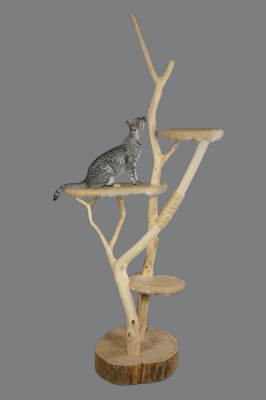
The post should be tall enough to allow your cat to scratch with extended forearms and while perched on their hind legs
Sadly, many cats are surrendered to shelters because of their scratching habits. While scratching of home furnishings can be frustrating and lead to damage and expensive replacement or repair work, scratching is a normal behaviour in cats. The primary reason cats scratch is to sharpen their claws. By scratching cats remove the outer sheath of the nail, sharpening it. Scratching is also a good way for cars to stretch, loosen up muscles and tendons. Cats have wee gland all over their bodies, including on their paws. When they begin scratching, pheromones are released onto the object as a way of marking their territory. Scratch marks can also be a visual marker to deter other cats. If your cat lives primarily outdoor, then scratching is probably not much of a problem as your cat will tend to use trees and fence posts to scratch their claws. If your cat lives indoor then you are more likely to run into problems.
What you can do
It is unreasonable to expect that your cat will never scratch. Even if they scratch outside they will likely still be inclined to scratch while they are inside. To avoid your catch scratching your furniture, you are best to provide an alternative such as posts and play toys. There are a number of different posts available including corrugated cardboard posts, sisal, carpeting material and wood.
Make sure you set the scratching pole up in a space that you cat frequents often, perhaps near their favourite sleeping spot. The post should be tall enough to allow your cat to scratch with extended forearms and while perched on their hind legs. If your cat often scratches carpet, mats or rugs then perhaps they would prefer a horizontal scratching post over a vertical one. Consider what materials your cat tends to scratch on. Many commercial posts utilise carpet, however some cats would prefer hessian, bare wood or sisal. It is important that the material used appeals to your cat.
If your cat has never used a scratching post before then you are going to need to spend some time working with your cat to help them learn their new trick. A catnip spray is a great way to attract your cat to their post. Each time you see your cat scratching in the wrong place, pick him or her up and take them to the post. Be sure to reward your cat with a treat and lots of praise when you see them scratching in the correct place. Another way to entice your cat to their post is to make a play centre. Most cats will find the space appealing if you include places for your cat to climb onto and into, add toys, ropes and things on springs. You may need to have scratching posts in a few locations.
You could try deter your cat from their favourite scratching place (AKA your heirloom sofa) by using a few different methods:
- Applying double sided tape to the affected area
- Cover scratched areas with plastic or aluminium foil, these are less appealing for cats
- Set up booby traps such as a stack of plastic cups that will topple over when the cat scratches
What to do if your cat continues to scratch?
Even if you do all the right things and spend lots of time working with your cat, your cat may still be determined to scratch your sofa to pieces. At this point your only option may to be to prevent your cat entering certain rooms. Remember that you should never physically punish a cat, this will more often than not correct the behaviour but cause fear and anxiety in the cat. You may consider a firm “no” and spraying the cat with a light spray of water as a deterrent.

